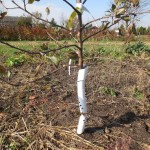Winterizing Your Garden
If you haven’t already done so, your roses and fruit trees will need some last minute tending before the snow stays for longer than a day.
Roses
For all non-climbing roses, you will need to cut the canes in half. Snow and ice can be detrimental to your plant if it’s allowed to build up over the winter. Keep the canes short to reduce the weight of snow on each cane.
 Hill up roses with 60 to 80 cm of triple mix. Hybrid teas, grandiflora & floribunda roses need winter protection. It gives me piece of mind, especially with the unpredictability of our Canadian winters.
Hill up roses with 60 to 80 cm of triple mix. Hybrid teas, grandiflora & floribunda roses need winter protection. It gives me piece of mind, especially with the unpredictability of our Canadian winters.
Water roses now if it hasn’t rained very much – although if your garden is like mine, it’s had its fair share of water this fall.
Rose plants that are young and those that face prevailing winds will benefit from a burlap covering. Extreme winds can desiccate a plant or damage branches.
For rose trees, put four stakes into the ground around the trunk. Make a burlap cocoon filled with leaves to protect the tree from whatever Mother Nature throws its way.
Fruit Trees
Your first step is to clean up the area. This removes dead leaves and possible pathogens that were either on your tree this past season or are harbouring in the decaying matter lying below your tree.
For the most part, you do not want to fertilize fruit trees in the winter. Fertilizer stimulates growth – something that can be detrimental to the tree’s success over the winter. Your tree is ready for a long sleep, let it rest.
 Use a plastic tree wrap to protect the trunk from rodents and sun scald. Sun scald occurs in winter when days are warm and sunny but nights are cold. The warm temperatures wake up the cells during the day but they become damaged when temperatures fall quickly.
Use a plastic tree wrap to protect the trunk from rodents and sun scald. Sun scald occurs in winter when days are warm and sunny but nights are cold. The warm temperatures wake up the cells during the day but they become damaged when temperatures fall quickly.
Unless the branch is already damaged, now is not the time to prune. Late winter / early spring is the best time, while the tree is still dormant. Pruning will stimulate growth but fall pruning can cause damage over the winter as the tree continues to heal itself and even try to grow.
The gardening season is not yet over. Take some time while the temperatures aren’t ridiculously cold to finish up some of these last minute projects.



